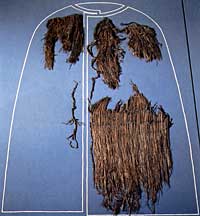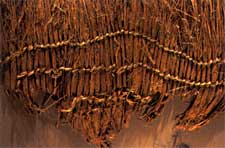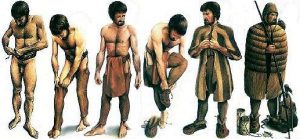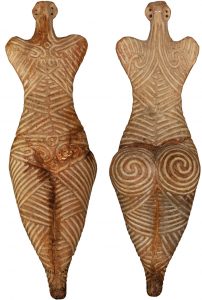Fashion of the Paleolithic/Neolithic periods
Paleolithic peoples would have worn and worked with materials that required very little assembly, preparation and maintenance due to a comparatively low intellect, nomadism, knowledge of construction, tools and I’m sure a number of other factors. The common themes among clothes would be essential a raw, or untreated, animal hide either draped or requiring very little sewing, which would have been accomplished with a needle of sorts most likely constructed from bone or some similar type material. It isn’t until the Neolithic period where we start to see more advanced thinking with tool making, agriculture, artwork, etc. Due to the “settlement” of early peoples in the Neolithic period, they were therefore able to devote more time and attention to certain things such as clothing. From the Neolithic period we see more bone tools, primitive holes made in animal hides, probably as a means to tie or hold two ends of the animal hide around the wearer, for example.


Artist: unknown
Title: The Iceman Ötzi’s grass cape
Date: 4th millennium BC
Retrieved from: http://mr_sedivy.tripod.com/iceman.html
Comment: This is an example of a grass cape which was probably from the Neolithic period since the cape is intricate and took a certain level of intellect and time to construct. This is a part of some of the articles which were found on and around the Fineilspitze, which is a peak in the Schnalskamm group of the Ötztal Alps on the border between Tyrol, Austria, and South Tyrol, Italy. Below is a recreation of what primitive man, such as Ötzi, may have worn.

Artist: unknown
Title: The Iceman Ötzi’s apparel
Date: 4th millennium BC, about 5,300 years ago
Retrieved from: http://www.crystalinks.com/otzi.html
Comment: This is an example of what primitive man such as Ötzi may have worn. This ensemble would consist of but may not have been limited to: hay-stuffed shoes, goat- and sheepskin coat, goatskin leggings, bear fur hat, grass matting and sheepskin loincloth.

Artist: unknown
Title: Venus of Willendorf
Date: 5th Millenium BC or approximately 4800 to 3000 B.C.
Retrieved from: http://www.archaeology.org/issues/109-1311/features/1349-cucuteni-figurine-romania-neolithic
Comment: This figurine was found in Romania and is believed to have been created by a people known as the Cucuteni culture. These demarcations are believed to be representations of tattoos while others argue they could represent clothing.

Artist: Naeem Khan
Title: uncertain
Date: 2014 RTW Collection
Retrieved from: http://www.thefashionlaw.com/home/did-j-crew-copy-naeem-khan-the-designer-thinks-so
Comment: Here is a dress from Naeem Khan’s 2014 collection and we can see how it may have been inspired by this Paleolithic figurine and it’s an example of how people can find inspiration anywhere and how patterns, styles, trends, etc., continue to be repeated and updated to fit new fashion and design standards, trends and interests.
This is a really neat blog post; never before have I even thought about paleo/neolithic fashion! I find it really interesting that some of the most iconic patterns are centuries old.